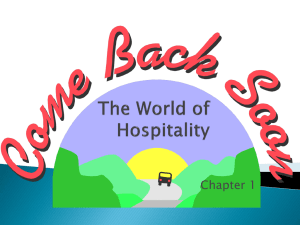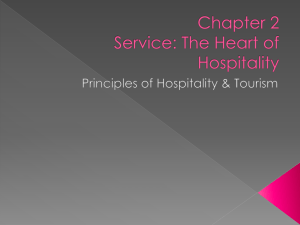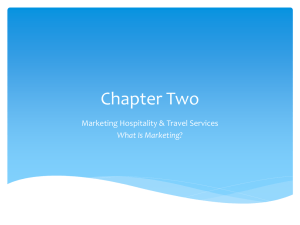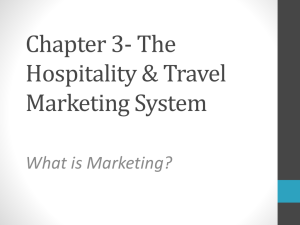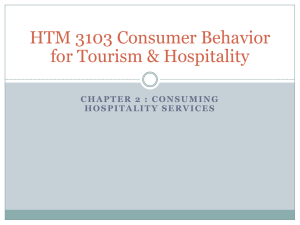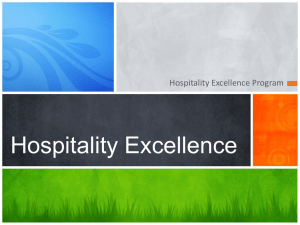Internal Marketing - Amazon Web Services
advertisement
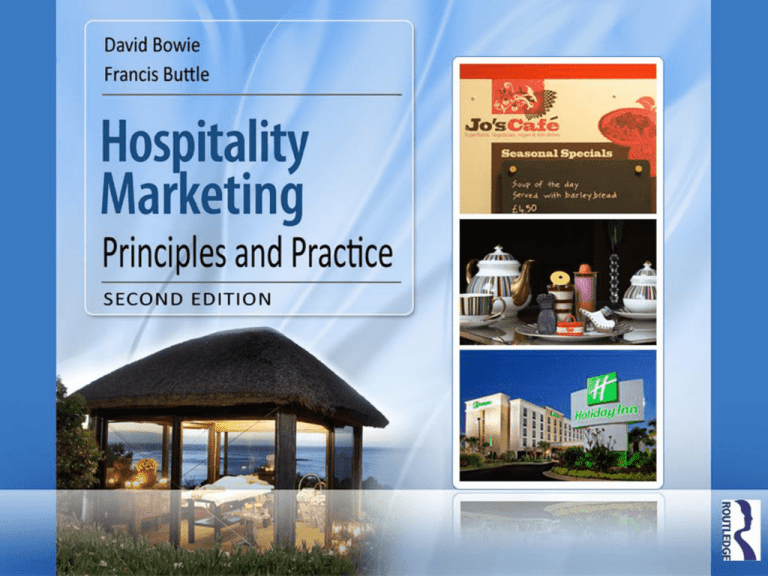
Chapter 12 Managing customer-contact employees Understand the importance of customer-contact employees in creating satisfactory or memorable customer experiences Evaluate service-orientated culture in hospitality companies Understand the concept of internal marketing and empowerment in a hospitality context Identify the sources of conflict for hospitality customercontact employees Employees play a crucial role during hospitality service encounter with customers The behaviour of customer-contact employees creates impressions of high or poor service quality and is critical to delivering customer satisfaction Employees also represent the hospitality brand Recruiting, training and rewarding employees is a human resource management function, but marketers need to understand employment strategies to ensure HR represents brand values and delivers the service experience promised by marketers to customers Human resource managers use marketing approaches to employee recruitment and retention – this is called internal marketing W. J. (Bill) Marriott (Snr)’s quotation summarizes the importance of employees – ‘it takes happy employees to make happy customers and this results in a good bottom line’ Customer-contact employees deliver on most dimensions of service quality: reliability, empathy, tangibles (partly), responsiveness and assurance The service profit chain demonstrates the link between employee satisfaction, service quality, customer satisfaction and business performance – see Figure 12.1 (Heskett, Jones, Loveman, Sasser and Schlesinger, 1994) Figure 12.1 The service profit chain Each hospitality organization has its own culture – its own DNA Company culture influence on how employees look after customers Company culture means the shared values, beliefs and assumptions that underpin how the organization operates, including the way that it treats its customers and employees Cultural components are deeply rooted in the organization’s founding history and recent development Employees learn organizational culture by observing the behaviour and messages from head office, the general manager and other employees General Manager as role model Characteristics of successful hospitality GMs vary, the personality, behaviour and actions of the GM sends powerful signals to the employees and helps to shape the culture Employee morale is a reflection of the general manager, and employees respond to the GM’s leadership Service myths, heroes and villains Companies can use examples of extraordinary employee actions in their advertising to promote their high quality service Eventually service myths create a dominant service culture personified by company heroes Maverick companies might employ characters (notably celebrity chefs) who are regarded as ‘villains’ and generate publicity – both positive and negative Support systems Employees are dependent on effective support systems, human and technological, to help to deliver appropriate service quality In hospitality, there is often conflict between front-of-house employees and back-of-house employees, especially (kitchen/restaurant) The services marketing triangle (see Figure 12.2) links preencounter marketing, internal marketing and marketing during the encounter Promises made to customers in pre-encounter communications have to be delivered during the service encounter Internal marketing recognises competition for best employees because business success is dependent on service quality, which is dependent on employees The following factors support positive employee recruitment and retention: recruitment, service inclination, service competence, training, empowerment and reward systems Figure 12.2 The services marketing triangle Zeithaml and Bitner, 2003 Recruitment Societies where tourism is a key industry (e.g. Caribbean), careers in hospitality are relatively well paid and enjoy high status Societies where hospitality has low status, pay and prospects, the recruitment challenge is difficult Company image/reputation as a good employer helps attract better employees Service inclination Employers seek employees with ‘right service attitude’. Some people natural aptitude for service; characteristics linked to attitude cannot be taught A problem for hospitality employers is lack of employees with right service attitude; if unsuitable employees recruited and service standards not delivered, customers and other employees will be unhappy Service competences Employees need skills and knowledge, called service competences, to be effective Historically, hospitality managers had limited education and learnt on-the-job Today, there are well-established hospitality/tourism education systems which helps to educate tomorrow’s managers Training Hospitality companies have own service culture, operating systems, service standards New employees need induction training to know product, service philosophy and company culture Best companies provide continuous training and career development Empowerment Employees work in boundaries set by companies which set rules about what employees are allowed to do or not to do An alternative approach empowers employees to take responsibility for ensuring customers are satisfied Empowerment needs to be matched with delegated authority and resources This approach is more customer focused and motivates employees Reward systems Reward systems include pay, bonuses, tips, free meals, discounted accommodation for live-in employees ‘Intangible benefits’ of hospitality work can compensate for unsocial hours and lower pay Intangible benefits include the excitement, fun and teamwork that many hospitality employees enjoy Employees can have interpersonal and interorganizational conflicts at work Conflict at work can be source and symptom of employee dissatisfaction Continuous or excessive conflict creates powerful emotional responses, including stress, for employees Understanding sources of conflict helps managers to create better working conditions Personal/role conflict – employees perform roles at work that might conflict with their own values, e.g. young people may resent a strict dress and grooming code Organizational/customer conflict Companies have policies, processes and Standard Operating Procedures to manage employee conduct Occasionally, customers can make reasonable requests which break the company’s regulations Inter-customer conflict Disputes between customers creates difficult situations for employees – especially if this happens on a regular basis Hospitality companies must develop effective strategies to recruit and retain service-minded customer-contact employees Companies use internal marketing to effectively communicate with employees Hospitality companies claim to be good employers The industry suffers from high employee turnover There is a strong link between employee satisfaction, service quality, customer satisfaction and business performance (the service-profit chain) Each hospitality company has its own culture which guides customer-contact employees in their behaviour towards customers Bitner, M. J., Booms, B. H. and Tetreault, M. S. (1990). ‘The service encounter: diagnosing favourable and unfavourable incidents’. Journal of Marketing, 54, pp. 71–84. Carlzon , J. (1987). Moments of Truth. Harper Collins. Customer Management. (2000). ‘Towards best practice’. Customer Management, July/August, pp. 6–11. Gummesson, E. (2008). Total Relationship Marketing (3rd ed.). ButterworthHeinemann. Heskett, J. L., Jones, T. O., Loveman, G. W., Sasser, W. E., Jr. and Schlesinger, L. A. (1994). ‘Putting the service profit chain to work’. Harvard Business Review, 72, pp. 164–170. Lashley, C. (2000). Hospitality Retail Management. Butterworth-Heinemann. Lashley, C. (2001). Employing Human Resource Strategies for Service Excellence. Butterworth-Heinemann. Mudie, P. (2000). ‘Internal marketing: a step too far’. In R. J. Varey and B. R. Lewis (eds) Internal Marketing: Directions for Management (Chapter 15). Routledge. Schneider, B. and Bowen, D. E. (1995). Winning the Service Game. HBS Press. Varey, R. J. and Lewis , B. R. ( 2000 ). Internal Marketing: Directions for Management. Routledge. Zeithaml, V. A. and Bitner, M. J. (2009). Services Marketing. McGraw-Hill. Figure 12.3 Higher and lower customer-contact service contexts – an example from food service


